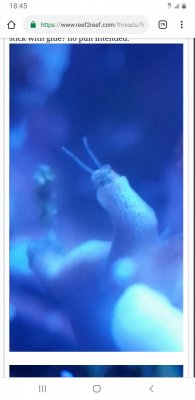- Joined
- Jul 24, 2017
- Messages
- 69
- Reaction score
- 39
Hi There,
Is anyone familiar with what's happening to this SPS frag? Rather than a polyp at the end of two of the new (now shrunken) branches, there's this... black thing with two antennae? The frag itself is recovering, showing little PE at night. Despite its lack of color it has grown 1/4" in the past month. Are these some type of pest and if so- how do i treat? Can't find anything in research about this type of thing.
Any direction is much appreciated
Thanks!

Is anyone familiar with what's happening to this SPS frag? Rather than a polyp at the end of two of the new (now shrunken) branches, there's this... black thing with two antennae? The frag itself is recovering, showing little PE at night. Despite its lack of color it has grown 1/4" in the past month. Are these some type of pest and if so- how do i treat? Can't find anything in research about this type of thing.
Any direction is much appreciated
Thanks!


















